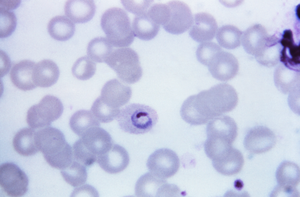Plasmodium ovale
| Plasmodium ovale | ||||||||||||
|---|---|---|---|---|---|---|---|---|---|---|---|---|

Plasmodium ovale trophozoite in a Giemsa-stained blood smear |
||||||||||||
| Systematics | ||||||||||||
|
||||||||||||
| Scientific name | ||||||||||||
| Plasmodium ovale | ||||||||||||
| Stephens , 1922 |
Plasmodium ovale is a protozoan parasite of the genus of the plasmodia and a pathogen of Malaria tertiana . Infections with this parasite are relatively rare and are usually comparatively benign. Like other malaria pathogens, Plasmodium ovale is transmittedby Anopheles mosquitoes . The parasite is found in some tropical countries.
Discovery and Description
history
Plasmodium ovale was the last of the classic human malaria pathogens to be discovered. John Stephens of the Liverpool School of Tropical Medicine identified the parasite in a blood smear from an East African malaria patient. The term oval comes from the oval shape of infected erythrocytes in the blood smear , a characteristic that is not observed in other malaria pathogens.
description
As with all plasmodia, P. ovale occurs in different stages of development. Liver schizonts are often oval in shape, about 50 by 80 micrometers in size, and contain hundreds of merozoites . When the parasite multiplies in erythrocytes, these are usually significantly enlarged and show characteristic Schüffner stippling , which is more prominent than in Plasmodium vivax . Mature blood schizonts contain 8 to a maximum of 20 merozoites. Immature gametocytes are microscopically difficult to distinguish from the asexual forms. The mature gametocytes fill the host cell completely; the parasites are surrounded by a distinct ring of pits. After staining, macrogametocytes show a medium blue cytoplasm with a prominent nucleus on the edge and pigment distributed in granules like pearl chains, while the microgametocytes show a light blue cytoplasm with a large nucleus.
Systematics
Plasmodium ovale , like most other primate infecting Plasmodia, is classified in the subgenus Plasmodium. The closer relationships to other species are unclear. Although P. ovale is similar in many ways to Plasmodium vivax , molecular studies do not show a particularly close relationship. With Plasmodium schwetzi there is also a species found in chimpanzees and gorillas, which shows great similarity to P.ovale microscopically and in terms of disease progression, but no molecular data for comparison are available for P. schwetzi . Some phylogenetic analyzes place P. ovale close to members of the genus Hepatocystis ; the status of this genus is itself unclear, however, since the genus Plasmodium is paraphyletic to Hepatocystis .
Distribution and host animals
Africa south of the Sahara and some islands in the western Pacific, especially New Guinea , are given as the distribution area for Plasmodium ovale . There are only a few reports from Southeast Asia, including from Indonesia, Thailand and Vietnam. It seems unclear whether the parasite has established itself there. The reasons for this restricted distribution area are unknown; suitable hosts and vectors can also be found in other tropical regions.
Humans are the only known reservoir hosts for Plasmodium ovale . Chimpanzees can be infected under experimental conditions, but this was not possible with macaques and New World monkeys . A number of Anopheles species can be infected with P. ovale and can be used as vectors . Anopheles gambiae and Anopheles funestus are considered to be important natural vectors.
Life cycle
The life cycle of P. ovale is essentially the same as that of other plasmodia. The parasite shows an obligatory change of host. The sporozoites get into the bloodstream of humans through infected mosquitoes, migrate from there to the liver and penetrate into hepatocytes , in which they reproduce asexually. The incubation time of this liver phase is about 9 days. The liver schizonts each produce hundreds of merozoites that are released and attack erythrocytes , where further asexual reproduction takes place. The generation time for the replication in the erythrocytes averages 49 hours. Since development is synchronous, there is a massive release of new parasites at the end of each reproduction cycle, which is associated with a fever. The term malaria tertiana is derived from the periodicity of the fever attacks.
A few plasmodia develop into sex forms in the erythrocytes. These microgametocytes and macrogametocytes can be ingested by mosquitoes with a blood meal and start a new development cycle in the insect's intestine. After the gametes fuse, new sporozoites are formed in the intestine that migrate to the salivary gland, from where they can be transferred to a new host. The development time in the mosquito is around 14 to 16 days.
Not all liver parasites are released into the bloodstream. There remain calm forms, called Hypnozoiten , in the liver, after weeks or months and recurrences can lead relapses mentioned. These hypnozoites must be eliminated by treatment with agents such as primaquine .
literature
- G. Robert Coatney, William E. Collins, McWilson Warren, and Peter G. Contacos: The primate malarias. Bethesda: US National Institute of Allergy and Infectious Diseases, 1971. Chapter 15, p. 171 ff .: Plasmodium ovale PDF ( Memento of December 28, 2009 in the Internet Archive )
- William E. Collins and Geoffrey M. Jeffery: Plasmodium ovale: Parasite and Disease. In: Clin. Microbiol. Rev. 2005 Vol. 18 (3), pp. 579-592, PMID 16020691
Individual evidence
- ^ Perkins SL, Schall JJ. A molecular phylogeny of malarial parasites recovered from cytochrome b gene sequences. In: J Parasitol. 2002 Oct; 88 (5): 972-8. PMID 12435139
- ↑ Martinsen ES, Perkins SL, Schall JJ. A three-genome phylogeny of malaria parasites (Plasmodium and closely related genera): evolution of life-history traits and host switches. In: Mol Phylogenet Evol. 2008 Apr; 47 (1): 261-73. PMID 18248741